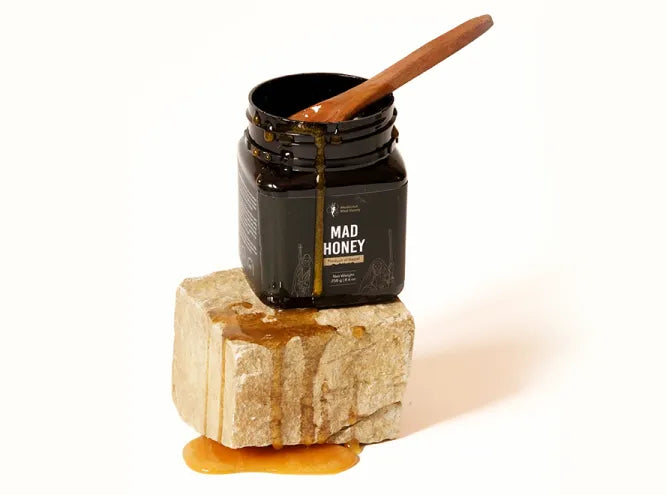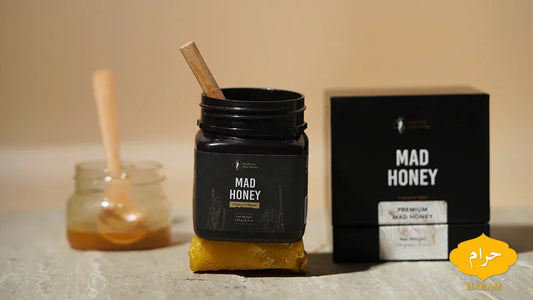Honey is nature’s food formed from flowers, exclusively made by honeybees. Particularly, Americans consume around 700 million pounds of honey each year, but not all consumers are aware of the test or even know wild honey!
The difference between the two types of honey is based on the floral, entomological and geographical origin. Besides the origin, the processing methods also differ substantially influencing the nutritional value of regular honey from the wild one.
Understanding Normal Honey

Among more than 2000 species of honey bees synthesizing honey, Apis mellifera (Western Honeybee) and Apis cerana (Asian Honeybee) are major contributors in the production of regular honey.
Bees play the role of primary pollinators and in the course of this process, they feed on the nectar of the flowers and store excess for future use which gets the term “honey”. This stored food is primarily used to feed the broods in the hive.
Source of regular honey
Bees producing regular honey feed on flowers. The flower source of this kind of honey can be broadly categorized.
Exploring Wild Honey
Wild honey, on the other hand, is made by feeding on the wildflowers. These bees in fact live in the wild and make shelters in the wild, freely.
Though both have the same source of food, wild honey carries a unique fingerprint of the local ecosystem. For example, the wild honey from Pacific wouldn't be same as that of the Southeastern parts in terms of flavor profile, constituents they contain and aroma.
Source of wild honey
Bees making wild honey feed on wild flowers only. As the source of their food, the flowers are untouched by humans, the final product comes out to be free of toxins and pollutants.
Purity
The regular honey we use has to go through purification processes like pasteurization before going to the market. As the bees producing regular honey are completely domesticated, the source they feed on is also a sort of controlled.
The purity of wild honey begins from the source as the bees roam around the wild freely searching for flowers and continues to the point it gets sold. Yes, that’s correct, wild honey is generally sold raw, meaning they don’t go through the purification processes that involves heating and filtration. The final form that comes to the market for sale is hence rich in natural pollen, propolis, antioxidants, vitamins and minerals.
Nutritional Value

As already mentioned above, our regular honey has to face high heat and other processes like filtration, making the process-sensitive nutrients degrade.
Wild honey doesn’t have to go through commercial processing, and as much as hundreds more beneficial compounds are present in it. Some of the nutrients that can be found in wild honey include:
-
Natural antioxidants: Flavonoids and phenolic acids present in wild honey protect the body from diseases related to oxidative stress.
-
Enzymes: Honey enzymes like glucose oxidase present in excess in wild honey give it its antibacterial properties.
-
Propolis doesn’t get filtered out in wild honey, best to support the immune system. Pollen is another compound in excess in wild honey that helps in building immune resilience.
-
Vitamins and minerals are abundant in wild honey which benefits overall health.
All these beneficial compounds stated above are also present in regular honey. Their limited availability is the only thing that makes it less potent in terms of health benefits.
Price Differences
Regular honey is commercially produced, so it’s available more easily in the market. Wild honey, on the other hand, is harvested in limited quantities as the hives are out there in the wild and limited in number. Moreover, the manpower needed in the process takes it to an even more expensive side.
Recommended Read : Why is Mad Honey so expensive?
Uses
Regular honey is widely used in place of sugar, be it in teas, desserts or any other recipes. It is also commonly used as a remedy of cough and sore throat, especially in kids.
Wild honey with its scent of the wildflowers is used in special cases. Just imagine, a drizzle of wild honey in your pancakes, every bite is aroma-filled, sweet and unique to what you are used to! Besides its use in baked goods, sauces and marinades, it has also been used as a remedy to heal sore throat, digestion problems and even to heal wounds.
Precautions
-
Neither of the honey types is for children aged <1, this precaution is important to prevent the chances of infant botulism.
-
As wild honey doesn’t undergo purification, it can have grayanotoxin. So, it is best avoided by pregnant women, new mothers and people with underlying conditions.
-
Anyone whose body is sensitive to pollen allergies or are allergic to other hive components should avoid wild honey and any other raw honey entirely.

Make Your Own Choice
Keeping in mind the nutritional value, budget constraints and uses of regular and wild honey, you can connect with any one of these humanity’s most cherished foods.
If you are still confused about which one to use and want to add both to your routine, you can choose regular honey when your lifestyle demands the replacement of sugar or other artificial sweeteners. And for occasional uses, where you want to cover your delicacies with the sweet aroma of the wild flowers, wild honey can be the perfect choice among the two.
FAQs
Q. Is wild honey better than regular honey?
A. Wild honey is better than regular honey in terms of the purity of the flower source and less processing it has to go through. Regular honey is also better in its own way, especially when you are using it instead of sweeteners like sugar.
Q. Which type of honey is the healthiest?
A. Raw forms of honey are healthiest in terms of nutrition as it does not go through any kind of purification processes, hence all the nutrients in it are retained.
Q. Is wildflower honey healthier than regular honey?
A. Wildflower honey is a raw honey type that doesn't go through processing. It has nectar of wildflowers, pollen, propolis and other nutrients in abundant amount, making it even healthier.
Q. Which honey types is best?
A. Raw and wild honey is best when it comes to choosing from the honey types. The fact that it comes from wild flowers and go through limited processing is what makes it stand out among all.
Q. Is wild honey better than regular honey?
A. Wild honey is often richer in enzymes, antioxidants, and pollen since it’s less processed, but both wild and regular honey provide similar natural sugars and health benefits. The difference lies in purity and nutrient retention.
Q. What's the difference between wildflower honey and regular honey?
A. Wildflower honey is made from the nectar of many seasonal wild plants, giving it a complex flavor and higher antioxidant diversity compared to regular (often blended) honey.
Q. What is the difference between wild forest honey and regular honey?
A. Wild forest honey is collected from bees in natural forests, often containing higher pollen, minerals, and antimicrobial compounds, while regular honey is usually farmed and filtered.
Q. What is the difference between natural and wild honey?
A. Natural honey refers to honey without additives, while wild honey comes from bees in forests or hives without human intervention—making it raw and less processed.
Q. What is the healthiest type of honey?
A. Manuka honey is widely considered the healthiest due to its high antibacterial activity, but raw, unprocessed honey from any source retains maximum nutrients.
Q. Why is wild honey so expensive?
A. Wild honey is costlier because it’s harvested manually from forests, limited in supply, and valued for its high purity, nutrients, and medicinal properties.
Q. Is wild honey healthy?
A. Yes. Wild honey is rich in antioxidants, enzymes, and antibacterial compounds that support immunity, digestion, and overall health when consumed in moderation.
Q. How to know if wild honey is pure?
A. Pure wild honey doesn’t dissolve quickly in water, crystallizes naturally over time, and has a distinct aroma. Lab testing is the most reliable method.
Q. Why is natural honey better?
A. Natural honey is better because it’s free from added sugars or syrups, retains antioxidants, and provides enzymes lost during processing in commercial honey.
Q. Is 100% natural honey the same as raw honey?
A. Not always. 100% natural honey may still be pasteurized, while raw honey is unheated, unfiltered, and contains more nutrients and enzymes.
Q. How to tell if Manuka honey is real?
A. Real Manuka honey has a UMF (Unique Manuka Factor) or MGO rating on its label, which certifies antibacterial activity and authenticity.
Q. Should raw honey be refrigerated?
A. No. Raw honey should be stored at room temperature in a sealed container. Refrigeration accelerates crystallization without extending shelf life.
Q. Is organic honey really worth it?
A. Organic honey ensures bees forage in pesticide-free areas and hives are chemical-free. While nutritionally similar, it’s valued for purity and eco-friendly practices.






1件のコメント
Liton
Good